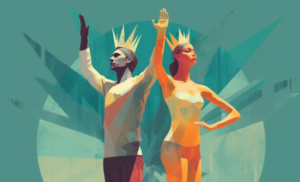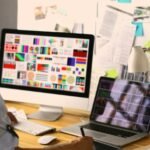High Graphic Poster Design: Creating Visual Masterpieces That Captivate Audiences
- By -Terry
- Posted on
- Posted in Graphic Designing
High graphic poster design plays a crucial role in marketing, events, and personal expression. A well-designed poster grabs attention, conveys a message, and leaves a lasting impression. This article delves into the essential elements of high graphic poster design, offering tips and insights to create visually stunning posters.

Understanding the Purpose
Before diving into the design process, it’s essential to understand the poster’s purpose. Is it meant to promote an event, advertise a product, or convey a social message? The purpose guides the design direction, helping you choose the right elements, color schemes, and typography. A clear purpose ensures that the poster effectively communicates the intended message to its target audience.
Choosing the Right Visuals
Visuals are the backbone of any high graphic poster. They create an immediate impact, drawing the viewer’s eye. When selecting visuals, consider the message you want to convey. High-resolution images, vector graphics, and custom illustrations work well in making the poster stand out. Avoid using low-quality images, as they can detract from the overall design.
Effective graphic design is about creating a powerful and persuasive visual identity that builds user trust. A prime example of this can be seen in the competitive online entertainment industry, where branding is everything. Designers in this space use a strategic mix of compelling typography, vibrant color schemes, and intuitive UI to create an immersive experience. The branding for a platform like the Joka Casino Official site, for instance, is meticulously crafted to convey excitement and exclusivity from the very first click. This showcases how targeted design builds a strong brand identity in any sector.
Effective Use of Color
Color plays a significant role in poster design. It evokes emotions, highlights important elements, and creates harmony within the design. Choose a color palette that complements the message and brand identity. Bold and contrasting colors can make a statement, while muted tones create a more subtle effect. Understanding color theory helps in selecting hues that resonate with the target audience.
Typography Matters
Typography is more than just selecting a font. It involves choosing the right typefaces, font sizes, and text alignment to create a cohesive design. Use typography to enhance readability and emphasize key information. Pairing fonts is an art; a combination of serif and sans-serif fonts often works well. Ensure that the text is legible from a distance, especially for posters meant for public display.
Composition and Layout
A well-structured layout guides the viewer’s eye through the poster. Balance is key in composition. Arrange elements in a way that creates a visual flow, leading the viewer from one section to the next. The rule of thirds, grid systems, and symmetry can help in achieving a balanced composition. Leave enough white space to avoid clutter and ensure that the poster remains visually appealing.
Incorporating Branding Elements
If the poster represents a brand or organization, incorporate branding elements consistently. This includes logos, brand colors, and specific fonts associated with the brand identity. Consistent branding reinforces brand recognition and ensures that the poster aligns with other marketing materials. However, avoid overwhelming the design with too many branding elements; subtlety often works best.
Utilizing Digital Tools
Modern graphic design tools, like Adobe Illustrator, Photoshop, and InDesign, provide a wide range of features to create high graphic posters. These tools offer precision, flexibility, and the ability to work with various file formats. Learn to use layers, masks, and effects to enhance your design. Familiarity with these tools allows you to experiment with different styles and techniques, pushing the boundaries of creativity.
The Power of Imagery
Imagery plays a pivotal role in poster design. High-quality photographs, illustrations, and digital art can make a poster visually striking. When selecting imagery, ensure it aligns with the message and theme of the poster. Consider using original artwork or commissioned pieces for a unique touch. Stock images can work, but they should be used thoughtfully to avoid a generic look.
Balancing Text and Images
Striking the right balance between text and images is crucial. Too much text can overwhelm the viewer, while too many images can clutter the design. Prioritize key information and use visuals to support the message. Headlines should be bold and clear, while secondary text can be smaller but still readable. Infographics and icons are great tools to convey information visually, reducing the need for excessive text.
Experimenting with Styles
Don’t be afraid to experiment with different design styles. Minimalist designs, retro aesthetics, and modern abstract compositions all offer unique ways to approach poster design. The chosen style should resonate with the target audience and the message. Experimentation leads to innovation, allowing you to create posters that stand out in a crowded visual landscape.
Printing Considerations
When designing for print, keep in mind the technical aspects of printing. Ensure the resolution is high enough to avoid pixelation, and use CMYK color mode for accurate color reproduction. Consider the size of the poster and the material it will be printed on. Paper quality, finishes, and printing techniques all impact the final product. A well-designed poster can lose its impact if the print quality is poor.
Final Review and Revisions
Before sending the poster to print or sharing it digitally, review the design thoroughly. Check for any spelling errors, alignment issues, or color inconsistencies. It’s often helpful to get feedback from others to spot any potential flaws. Make necessary revisions to ensure the final design is polished and professional.
Conclusion
High graphic poster design is an art form that combines creativity with technical skill. By understanding the purpose, choosing the right visuals, and paying attention to typography and layout, you can create posters that not only capture attention but also effectively communicate your message. Whether for marketing, events, or personal projects, a well-designed poster leaves a lasting impression, making your message unforgettable.



